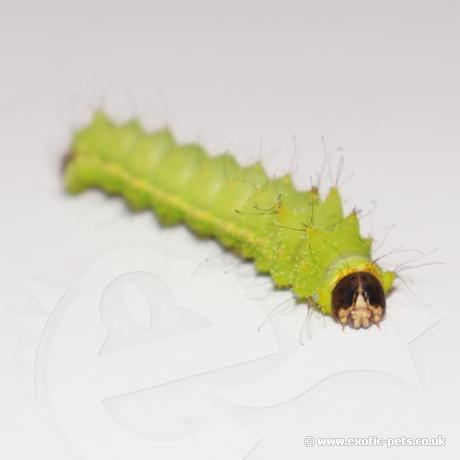

The Chinese Oak Silkmoth looks stunning as caterpillars with their bright lime green colour and little tuffs of hair along the back. Moths have tan coloured wing which reach a size of 10-14cm.
Starting as a newly hatched larva, these are quite noticeable; they have a black body with fine hairs. With each instar (shedding of skin) the colour brightens to a lovely lime green. The lower lateral tubercles are greenish-blue; a yellow-tan lateral stripe is present down each side of the body. Under bright lighting, the bases of the tubercles shine like diamonds. A fully grown larva will reach around 9cm in length before spinning a harden cocoon.
The moths wingspan is between 10-14cm for both sexes. The overall body and wing colour is brown and fawn; ocellus (eyes) are present on each fore and hindwings, these vary in colour to each individual moth with pink, yellow and black being present. The sub marginal line tends to be a pink-silver colour. Males are easily sexed by the large feathery antennae.
As the name would suggest, the Chinese Oak Silkmoth originally come from Southern Chinese; these have however been introduced to areas in Asia for the Tussah silk (wild silk) they produce.
Firstly the most important information for keeping any larvae alive is which food plant they eat. Larvae feed on the following; oak, hornbeam, chestnut, plum and apple.
Keep young larvae in small containers with a few tiny air holes; you can use a plastic tank with some netting over the top to prevent any escapees. As they grow increase the size of the tank, you may require a net enclosure depending on how many you are housing together.
Moving of the larvae should be done with great care. You should allow the larvae to walk onto a food plant rather than trying to pull it off as the pro legs and claspers (back legs) are very strong; you risk damaging and possibly causing death if handled to roughly.
The moths do not need to feed as they have no mouth parts; their sole purpose after emerging from their cocoon is to mate and reproduce. Pairing of this species is very easy, even in confined space.
The Chinese Oak Silkmoth may have two broods a year, after autumn they will cocoon over winter.